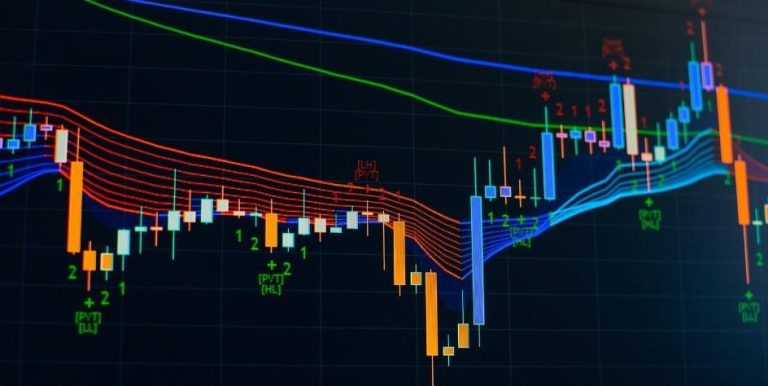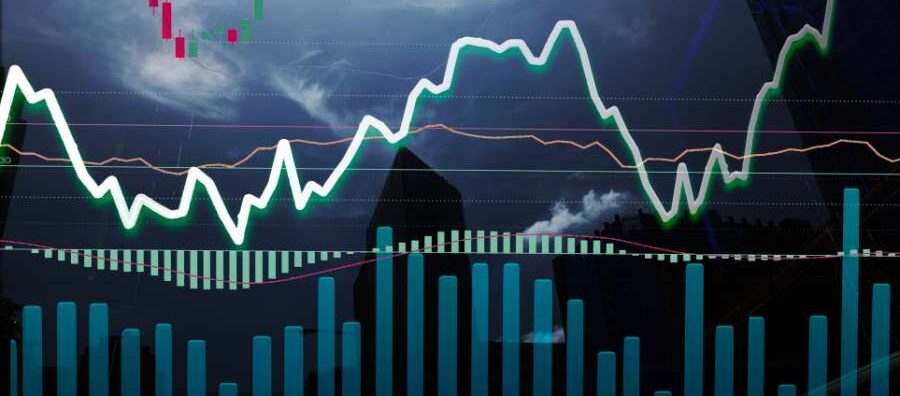The MA Indicator, short for moving average indicator, reflects the average price over a defined period in the past. Despite being the simplest technical indicators, it is widely used by traders of all experience levels. Furthermore, numerous other indicators, including the renowned MACD, are derived from the moving average concept.
In this article, we will delve into the fundamentals of the moving average, explore the differences between SMA and EMA, and examine the practical applications of the MA indicator through various trading examples.
MA Indicator Fundamental
The fundamental of the MA indicator is as straightforward as it sounds: By comparing the current market price to the average price over a past period, traders can determine the current market trend and anticipate potential future trends.
For example, if the market price of EURUSD is 1.08500, while its average price for the past five days is 1.08000, the market price is higher than the average price. This suggests that the market is currently in an uptrend, and traders should consider looking for buy opportunities.
The market price may be higher than the short-period average price but lower than long-time average. For example, if the current price is traded above 5 days MA but below 30 days MA, it suggests a short-term uptrend alongside a longer-term downtrend.
The period of the moving average is crucial, varying widely among traders. Long-term traders favor longer periods, while short-term traders prefer shorter ones. The relative position of short and long MAs provides key signals, elaborated further in subsequent sections.
SMA and EMA Indicators
Depending on the method of calculating average prices, there exist various variants of MA indicators, with Simple Moving Average (SMA) and Exponential Moving Average (EMA) being the most commonly used among them.
1). SMA(Simple Moving Average)
As its name implies, the Simple Moving Average (SMA) employs the simplest calculation method. The formula for SMA is straightforward:
SMA = Sum of Close Prices ÷ N
Here, N represents the calculation period. For example, if we are calculating a 10-day SMA on a daily chart, its value is determined by dividing the total close prices of the most recent 10 days by 10.
2). EMA(Exponential Moving Average)
The formula for EMA is more complex, but traders don’t necessarily need to understand the intricate mathematics behind it. Essentially, EMA assigns a greater weight to the price on the current day, with the weight decreasing as you move further back in time.
This means that recent prices have a stronger influence on EMA calculations compared to older prices. In other words, EMA can reflect the latest market move better and generate signals earlier. On the downside, EMA may produce more false signals.
3). Differences between SMA and EMA
In addition to their distinct calculation methods, the differing speed of response to market movements makes SMA and EMA suitable for different trading scenarios:
- The quicker response to market changes makes EMA particularly suitable for short-term trading.
- The slower respond of EMA provides stability and reduces false signals, making it better suited for long-term trading strategies.
Apart from SMA and EMA, another popular type of MA indicator is the Weighted Moving Average (WMA). Its calculation method closely resembles that of EMA, as it assigns higher weights to prices closer to the current time. However, WMA uses linearly decreasing weights, whereas EMA employs exponential weighting.
While the mathematics behind these calculations may be complex, what traders need to understand is that EMA tends to reflect the latest market movements more effectively than WMA. As a result, EMA is more popular among traders.
Moving Average Settings
The MA indicator represents the average price over a specified period, with its most crucial setting being the length of that period. We’ll illustrate Moving Average settings using the example of the EMA settings on TradingView – the world’s most popular charting.
The graph on the left is the EMA settings window on TradingView chart, it containts five parameters:
1. Length
The default setting is 9, but traders can adjust it to any whole number. For instance, setting it to 20 on a daily chart means that the EMA value is calculated based on the close price over the past 20 days.
2. Source
This parameter signifies the price type of each candlestick utilized in the calculation, offering options such as open, high, low, and close.
3. Offset
When setting the offset value to 1 on a daily chart, it means that yesterday’s EMA value will be displayed today. This advanced usage of the MA indicator allows for fine-tuning, but new traders can simply use the default offset value of 0.
4. Smoothing Line & Smoothing Length
The Smoothing Line is an additional line calculated based on the moving average of the MA indicator, providing further insight into price trends. The Smoothing Length refers to the period used in calculating this additional moving average.
The moving average settings in TradingView can appear complex, particularly with options like Smoothline and Smoothing Length. However, for new learners and most traders, adjusting only the Length parameter suffices. The Smoothline and Smoothing Length settings pertain to the usage of multiple MA lines, a topic that will be elaborated on later in this article.
Many new learners typically use the day as the measuring unit for the length of the MA indicator. For instance, a MA line with a length of 10 represents the average price over the past 10 days. While this is accurate for analyzing daily charts, traders often utilize other chart timeframes such as 15 minutes, 1 hour, 4 hours, and 1 week.
On an hourly chart, a length of 10 represents the average price over the past 10 hours, while on a weekly chart, it signifies the average price over the past 10 weeks. Therefore, the more accurate measuring unit for the length of the MA indicator is the number of candlesticks, where a length of 10 indicates the average price over the last 10 candlesticks.
MA Indicator Applications
Support and resistance are the key applications of the MA indicator:
Support in Uptrend: During an uptrend, the MA line often acts as a support level. When the market retraces and finds support at the MA line, it generates a buy signal. However, if the price breaks below the MA line, it indicates weakening momentum and may present a sell opportunity.
Resistance in Downtrend: Conversely, in a downtrend, the MA line functions as a resistance level. Any bounce towards the MA line provides a sell opportunity. Nevertheless, a breakout above the MA line could signal a potential trend reversal.
In summary, traders often use the MA line as a dynamic support or resistance level to make trading decisions, depending on the prevailing market trend.
The daily chart of gold displayed above illustrates an uptrend highlighted between the two vertical dash lines on the left. Here, the blue 10-day EMA line serves as an effective support level. Throughout this uptrend, numerous retracements occurred, presenting multiple buy opportunities.
However, on February 2nd, 2023, the price of gold broke below the 10 EMA support line, initiating a downtrend. In this downtrend, the 10 EMA transitioned into a resistance line, offering several sell opportunities when the market rebounded back to the line.
MA Indicator Evaluation
Now we understand that MA lines can serve as highly effective support and resistance levels. However, determining the optimal length of the MA indicator to maximize effectiveness can be challenging. There is no standard length, and what works well in one period may not be as effective in another.
A recommended approach is to set up multiple MA lines at the same time on the same chart and compare their performance to find the most suitable one.
General rule for evaluating MA line
In an uptrend, the effectiveness of an MA line increases when the market consistently finds support upon retracements to the line. Conversely, in a downtrend, the effectiveness of an MA line rises when the market frequently encounters resistance upon rebounds to the line.
In practice, traders may consider using an MA line as a buy or sell signal, if the market finds support or resistance at the line for the second time during retracements or rebounds, respectively, when the market approaches the line again.”
We will continue to use the example of the gold daily chart from the previous section to illustrate this concept. This time, we have added three EMA lines with different lengths:
- The blue line: 10 EMA.
- The yellow line: 20 EMA.
- The red line: 50 EMA.
Why did we choose these three lengths? Because we are assuming our trading duration ranges from one week to a few small weeks. For such relatively short-term trading strategies, it’s crucial that the MA indicator can react quickly to market moves. Therefore, shorter lengths such as 5, 10, 20, 30, and 50 are preferred.
In the uptrend following November 4th, 2022, both the 10 EMA and 20 EMA closely tracked the price of gold, providing effective support levels. Three marks, labeled 1, 2, and 3, on the chart will be used to demonstrate how to confirm the effectiveness of the 10 EMA and 20 EMA.
Mark 1
At this point, the gold price found support for the first time, coinciding with the presence of both the 10 EMA and 20 EMA. Traders should monitor these levels to see if the market retraces and finds support again.
Mark 2
Here, the gold price experienced a retracement following a rise. This retracement remained around the 10 EMA for 7 days, even retracing back to the 20 EMA once during this period. Eventually, the support levels of the 10 EMA and 20 EMA were confirmed with a long positive candlestick.
Following the general rule, traders can now refer to the 10 EMA and 20 EMA for new buy signals.
Mark 3
At this point, the gold price retraced to the 10 EMA and 20 EMA again, providing the first buy signal. Until the market broke down the support line in February 2023, the gold price retraced to the 10 EMA multiple times and found support, offering numerous buy opportunities.
Moving Average Crossover
Moving average crossover is a common application of two MA indicators, and there are two types:
1). MA Bullish Crossover
A bullish crossover occurs when a shorter-term MA line crosses above a longer-term MA line from below, indicating a buy opportunity. Essentially, a crossover is akin to using a single MA indicator, where the shorter-term MA represents the market price and the longer-term MA represents the average price.
When the short-term MA crosses above the long-term MA, it signifies the market price breaking above the resistance of the MA line, suggesting a shift towards bullish momentum and a potential buy opportunity.
The crossover lags behind the MA signal itself, functioning more as a confirmation tool for trading opportunities. We’ll demonstrate this concept using the example of a Nasdaq 100 Index daily chart below, where two MA lines are highlighted: the 10 EMA (blue) and the 20 EMA (yellow).
There are two bullish crossovers highlighted on the chart. Suppose we opened a long trade based on the bullish crossover on the left side of the chart, with the open price around 14,400.
However, it’s apparent that the 10 EMA acted as a robust resistance line during the downtrend on the left side of the chart. If we had entered the long trade immediately after the price broke above the 10 EMA, the open price would have been around 14,000, which would have been more favorable.
2). MA Bearish Crossover
When a short-term MA line crosses below a long-term MA line, it’s termed a MA bearish crossover, signaling a sell opportunity. In the example provided, there is also a bearish crossover, which indeed offers a good sell signal.
However, experienced traders may opt to enter the short position earlier by analyzing the 4-hour chart, where an obvious double-top pattern was observed.
Moving Average Alignment
In a strong trending market, multiple MA lines can align, serving as a reference for trading direction. There are two types of MA alignment:
MA Bullish Alignment
In an uptrend, all short-term MA lines move above their respective longer-term MA lines.
MA Bearish Alignment
In a downtrend, all short-term MA lines move beneath their respective longer-term MA lines.
When a MA bullish alignment emerges, it indicates a robust uptrend across all timeframes. As a result, traders should seek buy opportunities during retracements. Conversely, a MA bearish alignment suggests a strong downtrend across all timeframes, prompting traders to look for sell opportunities during rebounds.
MA bullish/bearish alignments reflect market sentiment, offering an overall trading direction. However, for precise buy/sell signals, traders should utilize support/resistance and crossover applications as explained in previous sections.
Summary of MA Indicator
There are numerous indicators and trading strategies derived from the MA indicator, all of which become more accessible once we grasp the knowledge explained in this article. To conclude, let’s summarize the trading signals generated from the MA indicator:
Moving Average Buy Signals:
- In an uptrend, any retracement to the MA line becomes a buy signal after the market finds support twice at the line.
- In a downtrend, a buy signal is generated when the price breaks above the resistance level of the MA line.
- A MA bullish crossover in a downtrend indicates a buy signal.
Moving Average Sell Signals:
- In a downtrend, any rebound to the MA line is a sell signal after the market finds resistance twice at the line.
- In an uptrend, a sell signal is triggered when the price breaks below the support level of the MA line.
- A MA bearish crossover in an uptrend signifies a sell signal.





